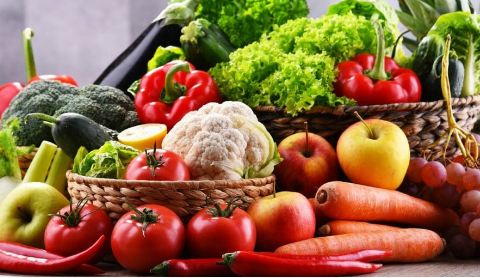Tehreem Muzammil
Fruits and vegetables are vital components of a healthy diet, providing essential nutrients, vitamins, and antioxidants. However, their perishable nature poses a significant challenge for the food industry, leading to substantial food waste and economic losses. Consumers increasingly demand fresh, high-quality, safe, and nutrient-rich produce, which presents a pressing need to improve storage and transportation methods to maintain these qualities.Traditional preservation techniques such as chemical additives, heat treatment, canning, aseptic packaging, and edible coatings have been employed to extend the shelf life of fruits and vegetables. While these methods can be effective, they often come with limitations. For instance, they can affect the flavor and nutritional value of the produce, be expensive, and not effectively target all types of microorganisms. In response to these challenges, nanotechnology has emerged as a promising solution, offering innovative ways to extend the shelf life of fruits and vegetables without compromising their taste, flavor, and nutritional value.Nanotechnology involves manipulating matter on an atomic and molecular scale, typically within the range of 1 to 100 nanometers. At this scale, materials exhibit unique physical and chemical properties that differ significantly from their larger-scale counterparts. These properties can be harnessed to develop novel applications in various fields, including medicine, electronics, and food technology.In the context of food preservation, nanotechnology offers a range of solutions for enhancing the shelf life and quality of fruits and vegetables. According to Maodab et al. (2011), nanoparticles can be used to create new packaging materials with improved mechanical properties and antimicrobial capabilities. This approach holds significant promise for addressing the limitations of traditional preservation methods.
Nanotechnology in food packaging is primarily applied through the use of polymer nanoparticles, which can be categorized into three main types:
- Improved Polymer Nanoparticle Food Packaging (PNFP): Nanoparticles enhance the flexibility, gas barrier properties, and temperature/humidity stability of polymer packaging materials. This results in packaging that better protects fruits and vegetables from environmental factors, thus extending their shelf life.
- Smart PNFP: These nanoparticles are designed to detect the condition of packaged food or its surrounding environment. For example, they can indicate changes in temperature or humidity, alerting consumers and retailers to potential spoilage.
- Active PNFP: This involves the use of nanoparticles that actively interact with food, packaging, and the environment. They help maintain freshness, prevent spoilage, and reduce waste by releasing antimicrobial agents or absorbing gases like ethylene, which accelerates ripening.
Applications of Nanotechnology in Extending Shelf Life
Several applications of nanotechnology have been developed to extend the shelf life of fruits and vegetables:
- Active Packaging: One of the primary ways to extend shelf life is through the development of advanced packaging solutions. Active packaging incorporates functional elements such as oxygen scavengers, ethylene removers, carbon dioxide absorbers and emitters, and antimicrobial properties. Nanoclays and nanosilver particles are used in active packaging to create films with improved mechanical and antimicrobial properties, reducing gas permeability. These films slow down ripening and kill microorganisms through mechanisms such as DNA damage and structural changes in cell walls.
- Nano Coating or Nanoemulsion: This technology involves creating tiny droplets of one liquid suspended in another, with sizes typically ranging from 10 to 100 nanometers. Nanoemulsions improve stability, bioavailability, and sensory properties such as taste, color, and flavor. For instance, nano-emulsion-based edible coatings with lemongrass essential oil (LEO) have been shown to inactivate E. coli on fresh-cut apples during storage more effectively than conventional emulsions. This method not only enhances safety but also maintains the sensory quality of the produce.
- Nanosensors: These offer cutting-edge solutions for real-time monitoring of produce freshness. Nanosensors can detect changes in environmental conditions, such as temperature and humidity, as well as the presence of ethylene gases, which can accelerate spoilage. By integrating nanosensors into packaging, it is possible to monitor the freshness of produce, providing valuable information to consumers and retailers.
- Nano-based Water Management: This technology reduces moisture loss by creating hydrophobic surfaces with nano coatings and absorbing water with nanoparticles. It maintains humidity by slowly releasing moisture through nanoemulsions and absorbing water as needed. This approach is particularly useful for produce that requires specific humidity levels to remain fresh.
- Nano Membranes:Nanomembranes play a crucial role in extending shelf life by controlling gas passage, preventing moisture loss, and blocking spoilage-causing microorganisms. They can also release active agents such as antimicrobial agents and antioxidants. Edible, smart, active, and nanoporous membranes are used to enhance the preservation of fruits and vegetables.
Future Directions and Trends
The potential of nanotechnology in food preservation is vast, with ongoing research and development efforts aimed at further enhancing its applications. Future directions include the use of materials such as copper, cerium oxide, and titanium oxide as coating agents, which could provide additional antimicrobial and barrier properties.Polymer nanotechnology is expected to deliver new packaging materials with improved capabilities, offering significant economic benefits. Market analyses predict that billions of dollars will be invested in food products utilizing nanotechnology in the next five years. As these technologies continue to evolve, future trends will likely focus on minimizing food waste and extending the shelf life of fruits and vegetables through advancements like personalized Nano coating, Nano biosensors, gene editing, quantum dots, and AI-integrated Nano systems.These technologies must meet future requirements, including microbial growth control, oxidation prevention, and improvements in the flavor, color, and texture of fruits and vegetables. Innovations such as personalized Nano coating could allow for tailored preservation solutions based on the specific needs of different types of produce.
The application of nanotechnology in extending the shelf life of fruits and vegetables holds tremendous promise. As global challenges related to food security, sustainability, and environmental stewardship continue to grow, nanotechnology is poised to play a vital role in addressing these issues. The development of innovative solutions such as Nano membranes, Nano coatings, and Nano sensors has significant potential to reduce waste, improve food safety, and enhance the overall quality of produce.By embracing these cutting-edge technologies, the food industry can not only meet consumer demands for fresh and high-quality produce but also contribute to a more sustainable and efficient global food system. As research progresses and new applications are developed, the impact of nanotechnology on food preservation is expected to grow, offering a promising future for the industry and consumers alike.
Tehreem Muzammil, BS Food Science and Technology

















